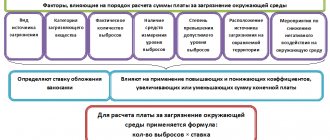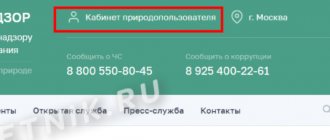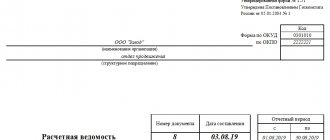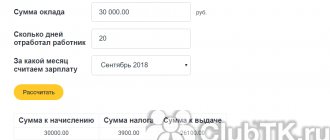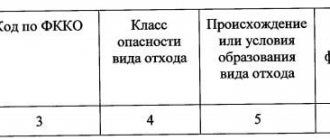- Who reports and pays for the NVOS?
- Innovation 1. New (almost) declaration form
- Innovation 2. The declaration will indicate the method for calculating advances
- Innovation 3. New coefficients for the formulas for calculating the payment amount
- Innovation 4. New coefficients for pay rates
- Innovation 5. Settlement of overpayment
- Innovation 6. New sheet with totals
- Innovation 7. Changes in the sheet where the fee amount is calculated
- Innovation 8. OKTMO of the object
Who reports and pays for the NVOS?
There are no changes here.
Just a reminder in case you're not sure if this applies to you. We described the conditions under which a company must report for the NVOS and the registration algorithm in the article “Reporting to the RPN for the NVOS: who should do what.” If these criteria are met, the company needs to submit reports and pay a fee for the NVOS (minus advance payments).
There are two exceptions:
- Legal entities and individual entrepreneurs who work exclusively at category IV facilities are exempt from reporting.
- Only SMEs are exempt from advance payments: they pay only the final amount.
Who shouldn't pay
Those organizations or entrepreneurs that carry out their activities only at facilities with hazard category IV do not have to pay payments for environmental protection. The following objects belong to the IV hazard category:
- where stationary emission sources are provided, with the total amount of emissions per year not exceeding 10 tons;
- where there is no release of radioactive substances;
- no discharges into sewers, underground and surface waters, or onto the ground.
If an organization has several facilities, but only part of them belongs to hazard category IV, then payment for pollution will have to be paid for all of the enterprise’s areas, including category IV.
Control over the calculation and transfer of fees is carried out by Rosprirodnadzor. Those organizations that operate facilities that have a negative impact on the environment of hazard categories I-IV are registered with Rosprirodnadzor. To do this, an application for each object is submitted in the prescribed form (approved by the Ministry of Natural Resources of Russia No. 554 of December 23, 2015). This must be done no later than 6 months from the start of operation of such facilities.
For violation of the deadline for registration with Rosprirodnadzor authorities, the organization faces a fine (Article 8.46 of the Administrative Code):
- 30,000 – 100,000 – per organization;
- 5,000 – 20,000 – per manager.
Registration of an object takes no longer than 10 working days, after which a certificate of registration is sent to the organization.
Innovation 1. New (almost) declaration form
If you remember, there were some discrepancies in the reporting for 2021. Two days before the end of the reporting campaign, the form for the declaration of payment for environmental impact assessment was changed (new edition of Order of the Ministry of Natural Resources dated January 09, 2017 No. 3). Those who submitted a declaration in recent days did so using a new form. But many managed to report according to the old one. This means that this time they will see the new declaration for the first time.
The names of the columns in sections 1, 1.1, 1.2 and 2 have changed:
| Was | It became |
| Maximum permissible emissions (MPE) | Permissible emission standards, technological standards (NDV, TN) |
| Temporarily agreed emissions (TCE) | Temporarily permitted emissions (TPE) |
| Permissible discharge standards (VAT) | Permissible discharge standards, technological standards (VAT, TN) |
| Temporarily agreed discharges (TCD) | Temporarily permitted discharges (TDR) |
The columns were renamed because the norms for NVOS objects of different categories have changed. Previously, all facilities, regardless of category, had to have emission permits, discharge permits, and waste disposal limits. Now the norms depend on the category of objects:
- For objects of category I, it is necessary to obtain a comprehensive environmental permit (IEP).
- For objects of category II, it is necessary to submit an environmental impact statement (EDD).
- For objects of category lll, the permitted masses of emissions and discharges are established according to the report on industrial environmental control (PEC).
Submit an IEE declaration via Extern
Section 3.1 of the declaration, which is filled out by enterprises with municipal solid waste disposal facilities, has changed. The number of columns has changed, new coefficients have appeared, similar to the coefficients in section 3.
In the calculation of fees for OKTMO, the names of some lines have changed and new lines have been added for fees for the placement of MSW.
Who should pay
It should be borne in mind that vehicles with exhaust gases are not related to such payment. Organizations that have a vehicle with 1 on their balance sheet are exempt from payment for negative environmental impact (Letter of the Ministry of Natural Resources No. 12-47/5413 dated March 10, 2015).
The following organizations and entrepreneurs are required to pay for environmental protection:
- air pollutants;
- polluting water resources;
- disposing of waste.
This payment is not provided for by the tax code, that is, it is not a tax, but everyone must transfer it, regardless of what taxation system the organization uses. This requirement also applies to foreign organizations; they are also required to make payments for environmental pollution.
It does not matter who has the right of ownership to the object that is the source of pollution. Even if an organization rents this facility or receives it for use free of charge, the one who actually uses it will pay for the pollution.
An environmental fee and a pollution fee are two completely different payments. An environmental fee is a disposal fee paid by businesses that produce goods (
Innovation 2. The declaration will indicate the method for calculating advances
From the first quarter of 2021, the user of natural resources can choose the calculation option for each type of environmental impact assessment, but must notify the RPN of which method he has chosen.
In the past, reports were notified by accompanying or separate letters. Starting with reporting for 2021, the method for calculating advances for the next year will need to be indicated in the declaration itself. The new sheet was introduced by order of the Ministry of Natural Resources of the Russian Federation dated December 10, 2020 No. 1043. It comes into force on January 15, 2021 and is valid until January 14, 2027 inclusive.
How to calculate advance payments for the tax assessment: 3 options
Before January 1, 2021, there was one algorithm for calculating advance payments for environmental impact assessments: the amounts for each type of negative impact for the past year were divided by 4 and transferred to the budget on time.
From January 1, 2021, three payment methods were introduced to choose from the payer (new edition of the Russian Government Decree dated March 3, 2017 No. 255):
- ¼ of the amount payable for the previous reporting period, as before.
- ¼ of the fee amount, but the payment base is determined based on the volume or mass of emissions and discharges of pollutants within the limits of standards (see Names of standards in the table above).
- First, we determine the payment base. As a basis, we take PEC data on the volume or mass of emissions (discharges), the volume or mass of disposed waste in the previous quarter of the current reporting period. Then we multiply the base by the payment rates with coefficients (Article 16.3 of the Federal Law of January 10, 2002 No. 7-FZ).
What are the bets and odds?
The amount of payments is established per unit of weight of environmental pollutants. The unit of weight is 1 ton of any type of waste, differentiated by the place of dumping. Stand out:
- discharges into the atmospheric air from stationary sources, deciphered by the name of the discharge;
- discharges into water bodies, deciphered by the name of the discharge.
The rate is set per ton of a harmful substance depending on its chemical formula. The coefficient is calculated as the reciprocal unit of the background concentration of the pollutant. Background concentration refers to the maximum permissible discharge standard. Simply put, if the background standard is a ton, then the discharge coefficient will be equal to 1.
In addition, additional rates have been established, differentiated by the class of hazard of their environmental impact.
Additional coefficients are applied in cases where business activity, and, accordingly, the dumping of production waste, is carried out in areas protected by Federal laws.
In addition to additional coefficients, there are also incentive coefficients from 0 to 0.33, established by the Federal Law “On Environmental Protection”. The purpose of incentive coefficients is to encourage the implementation of measures aimed at reducing the harmful impact on the environment.
Innovation 3. New coefficients for the formulas for calculating the payment amount
We calculate the tax payment for 2021 using formulas with new coefficients.
They were approved by Decree of the Government of the Russian Federation dated March 3, 2017 No. 255 (as amended on August 17, 2020). The same resolution provides calculation formulas (rules for calculating and collecting fees for the NVOS, hereinafter referred to as the Rules).
Payment for emissions and discharges within the limits of the standard (clause 17 of the Rules)
The formula for calculation is the same as in previous years. But there is one change. For organizations that operate centralized wastewater systems (CSS), a coefficient of 0.5 was introduced. CSW companies can use it if they discharge pollutants for which best available technologies for wastewater treatment have not been established. An exception is if the organization has launched a program to improve environmental efficiency or environmental protection measures.
Thus, in section 2 in column 15 for CSV organizations you need to enter 0.5. For all others this coefficient is equal to 1.
| Was | It became |
| Section 2, column 15 (Quo): coefficient 1 for all | Section 2, column 15 (Quo): for CSV organizations the coefficient is 0.5, for others - 1 |
Payment for waste disposal (except for MSW) within limits (clause 18 of the Rules)
We are talking about limits on waste disposal, about the standards specified in the DVOS or in the report on the generation, recycling, neutralization, and disposal of waste. The formula in section 3 has not changed.
Payment for placement of MSW in excess of established limits (clause 18 (1) of the Rules)
We are talking about limits on waste disposal, about the standards specified in the DVOS or reporting on the generation, recycling, neutralization, and disposal of waste.
From January 1, 2021, in section 3.1, a coefficient of 25 is applied to the rate of payment for the disposal of waste of the j-th hazard class in excess of limits. Previously, there was a coefficient of 5.
| Was | It became |
| In section 3.1, art. 13 (Ksl) coefficient 5 is applied to the fee rate | In section 3.1, art. 13 (Ksl) a coefficient of 25 is applied to the fee rate |
Payment within the limits of temporarily permitted emissions and discharges exceeding the standards (clause 19 of the Rules)
The coefficient for the payment rates for the emission or discharge of the i-th pollutant within the limits of temporarily permitted masses and volumes has changed: instead of coefficient 5, 25 is now applied (column 11, sections 1 and 2).
An exception is CSV organizations that have launched a program to improve environmental efficiency or environmental protection measures (except for discharges within the limits of technological standards). They apply factor 1 (column 11 of section 2 for CSV).
| Was | It became |
| Column 11 (Kvr) of sections 1 and 2 - all have a coefficient of 5 | Column 11 (Kvr) of section 1 and 1.1 - all have a coefficient of 25 Column 11 (Kvr) of section 2 - TsSV has a coefficient of 1, all others have a coefficient of 25 |
Payment for waste disposal (except for MSW) in excess of limits (clause 20 of the Rules)
We are talking about limits on waste disposal, about the standards specified in the DVOS or reporting on the generation, recycling, neutralization, and disposal of waste (with the exception of MSW).
From January 1, 2021, if the limit is exceeded, in Section 3 the coefficient of payment for disposal of waste of hazard class j is applied not to 5, as before, but to 25.
| Was | It became |
| Section 3, Art. 14 (Ksl) - coefficient 5 | Section 3, Art. 14 (Ksl) - coefficient 25 |
Payment for exceeding permitted emissions and discharges (clause 21 of the Rules)
We are talking about standards that depend on the category of objects.
- For category I objects, we look at the excess of emissions and discharges established by the IEP.
- For objects of category II we are talking about excess emissions and discharges from DVES.
- For category III objects, we mean the excess over emissions and discharges from industrial environmental control reports.
For objects of categories I and II, in columns 12 of sections 1 and 2, we use payment rates for emissions or discharges with a coefficient of 100 , and not 25, as before.
When CCB organizations conduct environmental efficiency programs or environmental protection activities, they, like others, use the coefficient 25 in column 12 of section 1, and in column 12 of section 2 they use the coefficient 1.
There are also those who use a coefficient of 25 in column 12 of sections 1 and 2. These are:
- persons who work at category III facilities and are required to pay fees;
- persons who work at facilities of categories I and II received a permit for emissions and discharges before January 1, 2021. The condition is valid until the permit expires, the company receives an IEP or submits a DVOS.
| Was | It became |
| All excesses of emissions and discharge standards were considered with a factor of 25 | For objects of categories I and II in columns 12 (Ksr/Kpr) of sections 1, 1.1 and 2, art. 5 section 1.2 - coefficient 100 |
| Column 6 of section 1.2 (Knmm) - coefficient 0.25 | |
| Column 12 of section 2 (Ksr/Kpr) TsSV: coefficient 1 | |
| For objects of categories III and II with permission before January 1, 2019 and subject to the conditions in column 12 (Ksr/Kpr) of sections 1 and 2 - coefficient 25 |
Payment for emissions and discharges in the absence of IEP, DVOS or a report on the results of the PEC (clause 21 (1) of the Rules)
We are talking about companies and individual entrepreneurs that operate at category I facilities and, from January 1, 2021, received or reissued a permit or limit on emissions and discharges. This also includes the situation when there are no such limits and permits.
Their coefficient was and remains 25, the payment base has changed. Now this is the actual volume or mass of emissions or discharges of pollutants in tons or cubic meters.
Calculate the fee for the tax assessment and send the declaration via Extern
As usual, the exception is CSV organizations. When they carry out programs to improve environmental efficiency or environmental protection measures, then in column 12 of section 2 they use a coefficient of 1.
Those who are required to pay a fee and work at category III facilities will apply a coefficient of 25 in column 12 from January 1, 2021.
Fee for disposal of recycled waste, except MSW (clause 22 of the Rules)
We are talking about the placement of waste that needs to be disposed of. The fee is charged if the company itself disposed of this waste at its production site according to technological regulations or transferred it for disposal no later than 11 months later. When calculating fees for such waste, a coefficient of 0 is applied in columns 18 and 21.
The payment base for waste disposal (except for MSW) of the j-th hazard class is considered as:
- Category I - the difference between the volume or weight of disposed waste and the volume or weight of established limits for their disposal;
- Category II - the difference between the volume or weight of disposed waste (except for MSW) and the volume or weight of waste in the DVOS;
- Category III - the difference between the volume or weight of disposed waste and the volume or weight of disposed waste, which is indicated in the report on the generation, disposal, neutralization, and disposal of waste.
If the company has not submitted a recycling report, the payment base is determined as the actual volume or weight of disposed waste.
Payment for emissions and discharges within the limits of technological standards (clause 17 of the Rules)
We are talking about emissions or discharges equal to technological standards. This also includes the case where a company has implemented BAT. In these situations, in column 10 of sections 1 and 2, we apply a coefficient of 0.
Calculation of environmental fee
Decree of the Government of the Russian Federation dated August 28, 1992.
No. 632 approved the Procedure for determining fees (and its limits) for environmental pollution, waste disposal, and other types of harmful effects. According to clause 2 of the above Procedure, two types of basic payment standards are established:
- For emissions, discharges of pollutants, waste disposal, and other types of harmful effects within acceptable standards .
The amount of payment for pollution in amounts not exceeding the maximum permissible standards established for the user of natural resources is calculated as follows:
- First, the amount of collection for each type of pollution is determined as the product of the established payment standards for the corresponding pollution and their magnitude.
- Then the results obtained are summarized for all types of pollution.
- For emissions, discharges of pollutants, waste disposal, and other types of harmful effects within established limits (temporarily agreed upon standards).
Payment for pollution within established limits is determined by multiplying the corresponding payment rates by the difference between the limit and maximum permissible pollution.

